Unusual Blooms | Unique Spring Bulbs Take Their Cues from the Classics
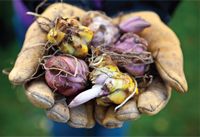
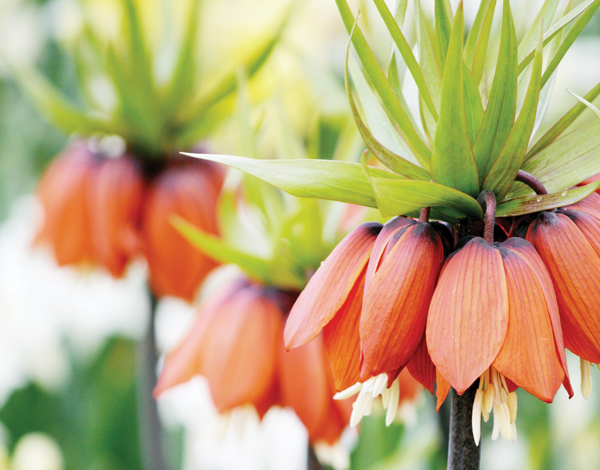
If you like spring flowers, now is the perfect time to think about planting bulbs. When you envision spring, images of gardens full of brightly colored pink tulips, yellow daffodils, and the traditional white Easter Lily probably come to mind. These classic bulbs have stood the test of time and will never go out of style. They are hardy, widely available, and will light up your yard with their bold beauty. But if you’re looking for some new and interesting varieties to make your spring garden bed a showstopper, consider these lovely oddities of the bulb world. If they’re not available at your local garden store, many online sites will deliver them to your door, and offer mixed combination packages for a splendid show of color.
Lilies
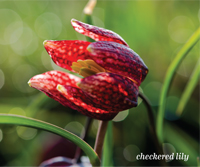 Checkered Lily (also known as Snakes Head, Guinea-Hen Flower, or Mission Bells): Checkerboards aren’t just for game rooms and retro tile floors. As its name suggests, this lily displays a checkerboard pattern on its bell-shaped petals. Alternating squares of white and deep maroon or violet are the draw for this unusual flower. It will grow up to one foot tall, and its grass-like foliage makes it a great choice for planting along a walkway or border, where it can be more easily noticed. It also works well in naturalized areas, where its strong, musky odor keeps deer and rodents away. And, unlike many spring bulbs, it tolerates moist soil and partial shade.
Checkered Lily (also known as Snakes Head, Guinea-Hen Flower, or Mission Bells): Checkerboards aren’t just for game rooms and retro tile floors. As its name suggests, this lily displays a checkerboard pattern on its bell-shaped petals. Alternating squares of white and deep maroon or violet are the draw for this unusual flower. It will grow up to one foot tall, and its grass-like foliage makes it a great choice for planting along a walkway or border, where it can be more easily noticed. It also works well in naturalized areas, where its strong, musky odor keeps deer and rodents away. And, unlike many spring bulbs, it tolerates moist soil and partial shade.
Crown Imperial Lily: Native to the Middle East, this unusual flower reaches a height of up to three feet and has a “crown” of thin, spiky, grass-like leaves above a cluster of blooms, which range from deep red to orange and yellow. It does best in full sun. Like the Checkered lily, it has an aroma that makes it deer- and rodent-resistant. It also has an illustrious history in our state: Thomas Jefferson was so intrigued by this strange flower that he acquired three bulbs in 1812. By 1816, his plantings at Monticello were strong enough for him to forward shoots to his retreat home, Poplar Forest, near Lynchburg. It is also planted at George Washington’s Mount Vernon; in 1784, the Marquis de Lafayette requested bulbs from Washington.
FLORISTS TO THE FIELD book signing, floral demo and wine reception
Farmbasket is pleased to partner with Pharsalia for a book signing, floral demonstration and wine reception featuring Greg Campbell and Erick New—co-owners of the celebrated Memphis floral shop Garden District— and their new book, Florists to the Field.
Florists To The Field, available at farmbasket, honors the hard working specialty farmers and growers that provide fields of flowers and an abundance of inspiration for collaboration. Florists To The Field is one of this floral design team’s most ambitious endeavors and a worthwhile testimony to their renown creative work. We’re thrilled to catch them on their tour en route to Monticello.
Enjoy an afternoon of flower arranging, book signing, wine tasting and our signature small bites sampling, creekside at farmbasket.
IF YOU ARE GOING
WHEN: Wednesday, September 19th, 4pm
WHERE: Creekside at farmbasket, 2008 Langhorne Rd., Lynchburg
TICKETS: 25.00 tickets are available at farmbasket
FOR MORE INFO: 434.528.1107
ABOUT THE AUTHORS
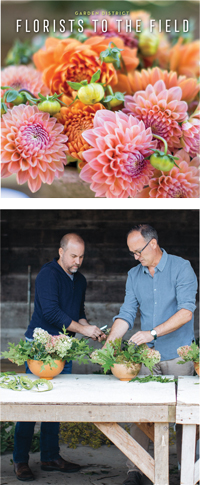 Garden District co-owners Greg Campbell and Erick New have grown a business of floral abundance and artistry one relationship at a time. A partnership of boundless creativity with an anything-can-be-done attitude, Greg and Erick never let reality get in the way of a great idea. On task they seem invincible, dream big, and realize their vision with exactness, always striving to surpass expectations.
Garden District co-owners Greg Campbell and Erick New have grown a business of floral abundance and artistry one relationship at a time. A partnership of boundless creativity with an anything-can-be-done attitude, Greg and Erick never let reality get in the way of a great idea. On task they seem invincible, dream big, and realize their vision with exactness, always striving to surpass expectations.
From plant breeders and flower farmers, to importers and exporters, to markets worldwide, Greg and Erick have navigated a vibrant labyrinth of activity together for 25 years. The curation of products in their Memphis showroom represents Garden District’s connection to floriculture across the U.S. and abroad. In turn, Florists to the Field is Greg and Erick’s tribute to the fellowship they share with specialty farmers and colleagues in the floral industry.
Florists to the Field is a testament to avant-garde resourcefulness that employs flowers to complement settings, mirror emotions, and enrich lives. Join Greg and Erick on their Florists to the Field journey. From the Deep South to the West Coast, through the Midwest and across the ocean to Holland, these are the places where they find inspiration.
Daffodils
Also called Narcissus, there are hundreds of daffodil varieties beyond the classic yellow ones we know and love. They are among the hardiest spring-flowering bulbs and require the least maintenance.
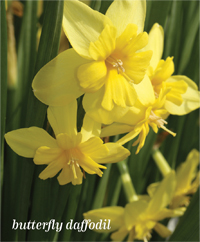 Butterfly Daffodil: The Butterfly daffodil has a smaller ruffled center cup instead of a long, slender trumpet, giving it a feminine, frilly appearance. It comes in a range of color combinations for both coronas (the petals) and center cups, including yellow, orange, peach, white and pink. Plant clusters of approximately six bulbs per square foot for a showy effect.
Butterfly Daffodil: The Butterfly daffodil has a smaller ruffled center cup instead of a long, slender trumpet, giving it a feminine, frilly appearance. It comes in a range of color combinations for both coronas (the petals) and center cups, including yellow, orange, peach, white and pink. Plant clusters of approximately six bulbs per square foot for a showy effect.
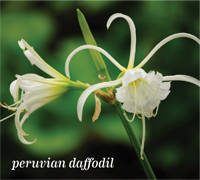 Peruvian Daffodil (also known as Spider Lily or Basketflower): A wildflower native to South America, this plant more closely resembles an amaryllis. Spidery, elongated curling petals give it an exotic look, and the flowers are fragrant and appear in early summer. Each plant can produce up to five flower clusters. Since it blooms in late spring to early summer, try tucking it around bulbs or perennials that bloom earlier in the season.
Peruvian Daffodil (also known as Spider Lily or Basketflower): A wildflower native to South America, this plant more closely resembles an amaryllis. Spidery, elongated curling petals give it an exotic look, and the flowers are fragrant and appear in early summer. Each plant can produce up to five flower clusters. Since it blooms in late spring to early summer, try tucking it around bulbs or perennials that bloom earlier in the season.
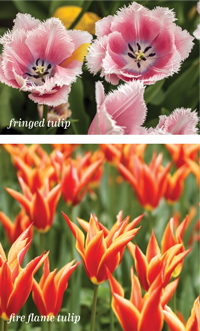 Tulips
Tulips
Fire Flame (also known as Horned or Turkish Tulip): Fire flame is aptly named; its clusters of narrow, pointy blooms—in yellow with bright red streaks—look like tendrils of fire. This wilder cultivar of the tulip is quite showy, and is an heirloom variety that dates back to at least the early 1800s. They can be planted in full sun or partial shade.
Fringed Tulip (also known as Crispa Tulip): There are multiple varieties of this tulip group, which features stunning frayed petals in an almost crystalline effect. They come in white, pink, apricot, yellow, orange, red, and violet. Some of the varieties even come in double flowers, for double the petals.
Planting Bulbs
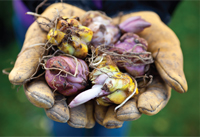 When: Keep your bulbs in a dry, dark, cool place until you are ready to plant. You can plant them about six weeks before the ground freezes or after the first hard freeze. You might get the best results by planting bulbs as soon as possible after purchase.
When: Keep your bulbs in a dry, dark, cool place until you are ready to plant. You can plant them about six weeks before the ground freezes or after the first hard freeze. You might get the best results by planting bulbs as soon as possible after purchase.
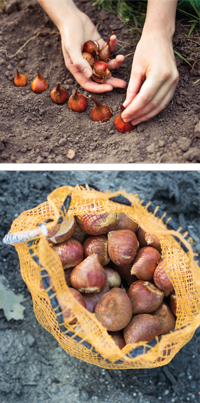 How: The perfect planting depth for each bulb is about two-and-a-half times as deep as the bulb is tall. (Follow instructions that come with each bulb purchase). The simplest and most attractive planting method is to dig out an area to the proper depth, plant bulbs in clusters or drifts, then cover with dirt and an extra layer of compost or mulch. If the winter is dry, water the area once a month and add extra mulch. You may also want to add a rodent repellent or cover part of the ground in chicken wire—remove as the bulbs begin to sprout.
How: The perfect planting depth for each bulb is about two-and-a-half times as deep as the bulb is tall. (Follow instructions that come with each bulb purchase). The simplest and most attractive planting method is to dig out an area to the proper depth, plant bulbs in clusters or drifts, then cover with dirt and an extra layer of compost or mulch. If the winter is dry, water the area once a month and add extra mulch. You may also want to add a rodent repellent or cover part of the ground in chicken wire—remove as the bulbs begin to sprout.
Where: A good tip is to plant your bulbs among or behind later-blooming perennials, to conceal the foliage when it dies and turns brown. Look for a welldrained spot that has plenty of early spring sunshine.
After blooming: Allow the bulb foliage to brown and die naturally, since the leaves are still a food source for the bulb in the ground. If you remove the foliage too soon, it will weaken the bulb and lead to fewer blooms next year.
Butterfly Daffodil, Checkered Lily, Crown Imperial Lily, Daffodils, Fire FlameTulip, Fringed Tulip, garden, Narcissus, Peruvian Daffodil, Planting Bulbs






